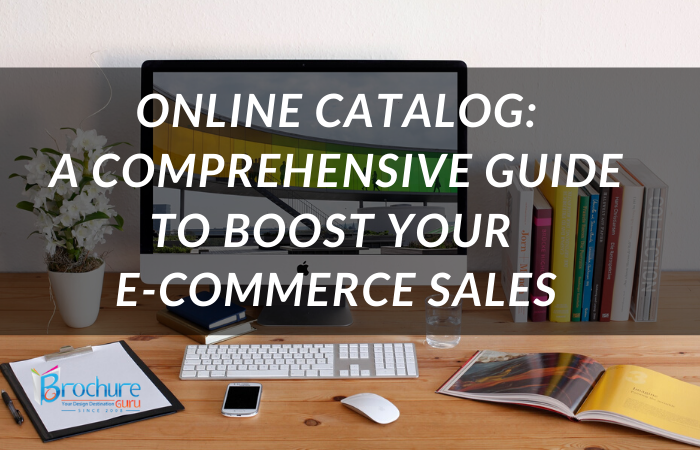Catalogs have widely been used as a key advertising material type by businesses for many decades. An eye-catching catalog with product images and information helps customers to make purchase decisions and also create trust for a brand. While printed physical catalogs are as relevant as ever, digital ones distributed online are becoming more prevalent. An online catalog is one of the most potent tools at a time when numerous businesses are taking the e-commerce route. They still look the same and work the same. But, customers find web or online catalogs more accessible and practical.
Changing buyer behaviors is a major reason why many businesses are looking beyond the traditional print catalog approach. It has also given rise to the popularity of e-catalogue design services across the globe. Moreover, it makes sense to let customers explore products online if they are buying online anyway. In some ways, online catalogs are more beneficial than their physical counterparts. Read on to get a better idea about the key ones.
Benefits of designing an online catalog
E-commerce businesses can experience distinct benefits of using e-catalogs or online catalogs today. The key advantages of opting for them are –
1. Online catalogs make e-commerce platforms more convenient – Recent studies have shown that most smartphone users now search for product information on their devices before making a purchase decision. This is true regardless of whether they are shopping online or visiting offline stores. Mailing physical catalogs to people does not work anymore as most individuals prefer researching businesses and products online. This has prompted many e-commerce business owners to deliver improved online experiences for existing and potential customers. Online catalogs add more accessibility to e-commerce websites. Potential customers like the convenience of viewing catalogs on their screens and proceeding to the product page.
2. Brands can boost their sales volumes with online catalogs – many businesses are relying on e-catalog services to enhance their sales figures. An e-catalog is a proven tool to help e-commerce brands sell more. It has to do with the fact that online catalogs can have direct links to products within them. So, when a user is browsing through a catalog and likes a product, clicking on it can take them directly to your product page. This is quite more convenient than having to see something in a physical copy and manually searching it online. It is no surprise why digital catalogs succeed in selling more.
3. Dynamic content of e-catalogs raises e-commerce engagement – Physical catalogs are limited to static images and text content. On the other hand, an online catalog can have many multimedia elements including high-definition images, animations, embedded videos, helpful internal links, pop-ups and dynamic calls to actions. All of these can engage potential customers better than any paper catalog ever could. Readers will get a richer and more fulfilling experience of browsing through and selecting suitable products. They can also buy on impulse if they want to. Improved engagement can raise the interest of potential buyers significantly.
4. Enables businesses to track and analyze engagement results – As mentioned above, e-commerce digital catalogs can have a wide range of multimedia elements within them. All these elements are interactive and the interaction activities can be tracked. This is one of the main motivations for using an online catalog for your e-commerce business. Click tracking is the method used for tracking which elements i.e. videos, CTAs, images, etc., people have interacted more with. Upon analyzing the tracked data, business owners can further streamline and enhance the online catalog.
5. Online catalogs create better shopping experiences – Online catalogs are the practical option for most e-commerce businesses as they offer far better and less disruptive online shopping experience. It makes perfect sense too. Why would one care about a company’s physical catalogs when its competitor offers and online alternative from where they can directly purchase something? This is why e-commerce platform owners are focusing on creating eye-catching e-catalogs to advertise their products and services now. It is high time businesses realized that most customers prefer the convenience and instant gratification. So, being able to see a product and instantly buy is quite appealing.
6. Gives businesses the ability to reach more customers – The reach of physical catalogs is quite limited when compared to the unbound potential of their online alternatives. If you are reaching 5,000 people by mailing catalogs, know that it is possible to reach ten times more through an online e-catalog. So, you can save the costs of printing and paper, and also maximize your business reach without much effort. Companies providing e-catalog services are experiencing huge demand as increasing numbers of business owners start realizing the benefits. Some tactics of improving your reach include sharing your catalog on social media sites, recommending products to customers while recommending them to check out the catalog, and interacting with them. Winning over your customers will also encourage them to spread the word, which translates to even greater reach for your e-catalog.
How online catalogs revolutionized the e-commerce sector
E-commerce is a business sector that does not involve anything offline, especially when it comes to the customer side of things. Individuals browse products online, see the specifications and prices, compare across platforms, and finally go through the purchase steps. So, advertising the products to them through and online catalog is a good idea when it comes to expecting substantial conversion results. No customer today likes exploring products on a piece of paper and then having to type in a website name or address. Technology has come a long way and there is simply no need for such a backdated shopping experience. E-catalogs has transformed the e-commerce sector as they have –
- Made it easier for businesses to advertise their products effectively
- Opened up the possibility of attracting more prospective buyers
- Positively impacted engagement with help of interactive elements and CTAs
- Enhanced the conversion process by simplifying the journey from product browsing to taking purchase steps.
Things you need to design e-catalogs (knowing your audience, CMS software and design tools)
How does a business owner proceed to get a suitable e-catalog designed? What are the basic requirements? Take a look –
1. Knowing your audience – The very first step for designing an e-catalog is identifying one’s target audience. You want to have a thorough idea of who you are catering to before availing any e-catalog services. The type of product catalog design will vary greatly depending on whether you are targeting B2B or B2C customers. Age, interests and location are some of the key factors to take into consideration for planning the design. Knowing your audience is important to determine factors like layout, design styles, fonts and product placement. Having relevant design elements is instrumental for generating interest, engagement and conversions,
2. CMS software – A CMS or content management system is another important prerequisite for keeping your catalog products organized. It lets you effortlessly add or remove products whenever necessary, and products can also be shuffled around with equal ease. The best option is a product content management software, which is specifically designed for e-commerce businesses. Adding product information and maintaining the quality of content across all e-store channels.
3. Catalog design tools – Designing a catalog requires designated design software with features for creating attractive patterns and layouts. Software such as Adobe InDesign can do the job due to its rich set of features. Your online catalog design should be exportable to different formats if necessary, shared, or made into physical printed copies. Integration with InDesign and your product information management software can also help you speed up design modifications. Image editing tools may also be required for catalog design.
Tips for presenting your products in a compelling manner
Certain things should be taken into account in order to design and develop an eye-catching e-catalog. These include
- Deciding how to best present products through the catalog to customers
- Deciding the number of images that need to be showcased for each product in the catalog
- Arriving at a decision regarding the font, font color, background color, etc.
- Whether to include videos, three-dimensional product demos, and animations
- Whether products have to be profiled with the help of professional photographers
Having clarity about all the above-mentioned aspects will help business owners instruct professionals providing e-catalog services about how to proceed. They can put your vision into use and add their own creativity to create a stunning product catalog. You can decide on giving readers a simplistic experience like any conventional catalog, but with the call to action links. Alternatively, you can create a stylish flipbook with more interactive elements. This depends on the demographics you are targeting with the e-catalog.
Step-by-step guide to online catalog creation
Catalog design should always be approached as a stepwise process to ensure fluid and trendy design. Following each step precisely is quite necessary to ensure the best results. Take a look at the fundamental ones mentioned below –
Step 1
Selecting products to include – The first step of developing your business’s e-catalog is to choose what products you want to include within it. Product information management software platforms like Sales Layer, and others, can be used to add, remove and manage all details. You can choose to organize products in any intended structure, import all products or select specific ones to import. Uploaded products can be put into different categories, subcategories, and families based on your preferences.
Step 2
Creating a datasheet – Having all relevant product information and specifications in place is important for putting them into an online catalog. Use the PIM software of your choice to enter details such as family, category, product numbers, product code, etc. Update all this information and save it for importing for the purpose of creating an e-catalog.
Step 3
Standardizing technical data and descriptions – Inputting product information manually into an e-catalog is a draining process that can also result in errors. This can be avoided completely using yeh automation features of PIM software. Such features help to highlight any issues with product descriptions so you can immediately get to fixing those. Anything missing will also be pointed out and you can fill it up.
Step 4
Linking your online catalog to different store platforms – Your sales catalog can exist across many different e-commerce platforms such as BigCommerce, Shopify and Magento, and famous marketplaces like Amazon, Google or Alibaba. PIM software can also be used for connecting your catalog to social networks such as Instagram and Facebook. Many product management software has built-in features for online and social integration.
Step 5 (optional)
Exporting and printing your online catalog – The stylish catalog you created for online use can also be utilized offline. Many business owners who avail e-catalog services also decide to get some copies for sharing with their business associates or prospective investors. You can get exact physical copies and circulate them for your offline advertising or promotional efforts. The design can be exported as PDF files using Adobe InDesign, for printing onto physical materials. You can choose only certain content to be printed from your PIM application, which may also enjoy integration with InDesign.
These are the five most important steps for bringing an e-catalog to life. Convey your idea of the catalog to designers and also listen to their inputs. Creating a demo catalog layout can be of help when it comes to envisioning the finished product. Business owners should ideally opt for availing reputed online catalog design services professionals for the best results.
The right e-catalog design can work wonders for any e-commerce business today. Including some interactive elements makes things more exciting for prospective buyers as you can capture their imagination better. Stylish catalogs with attractive visuals and crisp, to-the-point product information are what customers of today expect from a brand.
A digital catalog made by e-catalog services professionals can act as a shot in the arm for a business struggling to gain conversions. But, it has to be designed while considering factors like the target audience, their interests, and behavioral trends. Get in touch with a well-known catalog design company for custom design services.


 Email:
Email: 













